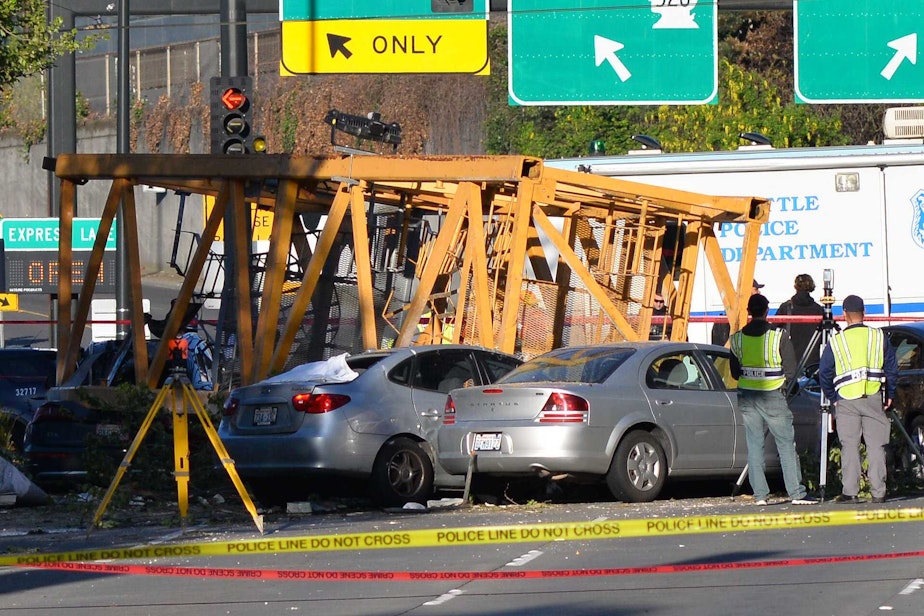Crane collapse likely caused by human error, experts say

At least 50 tons of steel fell from the sky when a tower crane in Seattle’s rapidly growing South Lake Union neighborhood collapsed on Saturday.
Crane experts contacted by KUOW say human error, not wind, likely toppled the crane as workers were dismantling it.
Saturday was windy, with gusts of up to 23 miles an hour reported by the National Weather Service as crews were taking down the construction crane—one of 60 currently dotting the Seattle skyline.
But tower cranes are built to withstand much stronger winds.
When this crane collapsed, killing four people, the big cross-piece at the top, with lifting equipment on the front and counterweights on the back, had already been removed.
That left only the skinny, vertical tower behind, less prone to wind and far lighter than a fully assembled crane, with the operator’s cabin perched on top.
“At 23 miles an hour, it shouldn't have been a problem to take that thing down," said Tom Barth, a crane inspector in South Carolina. “In Florida, where they had the hurricanes, they had the same type of tower cranes, and they let them weather vane in storms. And some of those winds are up to 100 and some miles an hour, and they still don't fall down.”
When a tower crane’s work is done, it is dismantled and moved to its next job.
First, the horizontal “jibs” are removed, bit by bit to maintain balance front to back. Then the support tower is removed, section by 20-foot section.
Tower sections are held together by burly, high-tensile steel bolts or “pins.”
On some tower cranes, these tight-fitting pins are two inches thick and installed with sledgehammers.
Pins that hold each section to its neighbor are removed and the sections lowered by another, mobile crane to a platform truck on the ground, one or two sections at a time.
The trucks typically have 40-foot flatbeds, allowing two sections to be transported at once.
On Saturday, at least six of those sections, weighing 7 tons each on this model of German-made Liebherr crane, plummeted onto busy Mercer Street and the roof of Block 25, which includes offices for Google and an apartment tower above.
“You know somebody screwed up and you know it'll come out in the investigation," said crane inspector Ron Brodek of Arizona.
He said bolts must have been removed too soon.
“You see tower sections laying on the ground, and they're not attached to anything,” Brodek said.
“If the pins were in, that crane would not have come down,” Barth said.
Barth said the crane collapses he has investigated on the East Coast had been caused by pins being removed prematurely, instead of following each crane manufacturer’s precise protocols for dismantling its products.
Vulcan Real Estate is developing Block 25, with head contractor GLY Construction of Bellevue.
In a statement, GLY said it is cooperating with investigators and referred all questions about the collapse to them.
Washington Department of Labor and Industries opened an investigation into the disaster over the weekend. It is expected to take six months or more.
Contractors working for GLY include:
- Northwest Tower Crane Services. “Northwest Tower was the one physically taking apart the parts of the tower crane,” Labor and Industries spokesperson Tim Church said.
- Omega Morgan. “Omega was operating the mobile crane being used to move the parts of the tower crane once they were taken apart,” Church said.
- Morrow Equipment Company owns the tower crane and would have had a “disassembly director” on site, according to Church.
All four firms are being investigated.
Mandi Kime, safety director for the Associated General Contractors of Washington, said all four firms have “outstanding” safety records.
After the state’s most recent fatal crane accident in Bellevue in 2006, Washington beefed up its regulation of tower cranes, including requiring third-party certification of crane operators.
Kime called Washington a national leader in crane safety. “We have a lot more regulations in that regard than anywhere else in the country,” she said.
“All folks involved with accident were qualified per the new rules and standards,” Kime said.
According to Labor and Industries safety data obtained by KUOW, GLY and Northwest Tower Crane Service of Des Moines, Washington, had above-average safety records from 2013 to 2016, while Fife-based Omega Morgan’s was below average.
The agency’s data did not include a safety rating for Morrow. The Salem, Oregon-based firm describes itself as the nation’s largest tower crane company.
Update, April 29, 5:30 p.m.: The Department of Labor and Industries has added a fifth firm to its investigation: Woodinville-based Seaburg Construction Corporation, which employed the tower crane operator.




